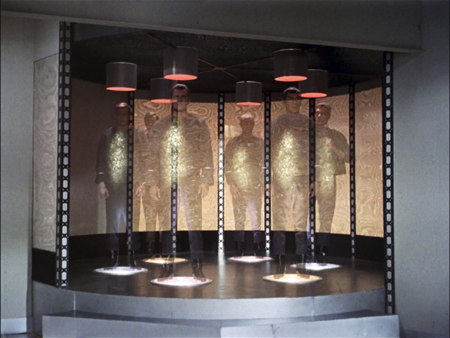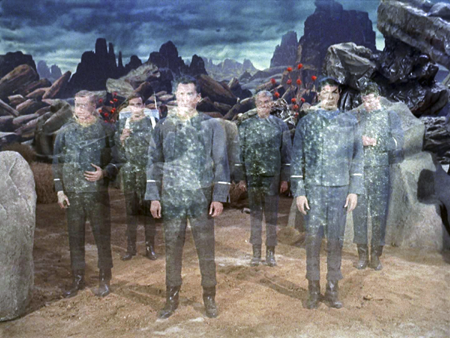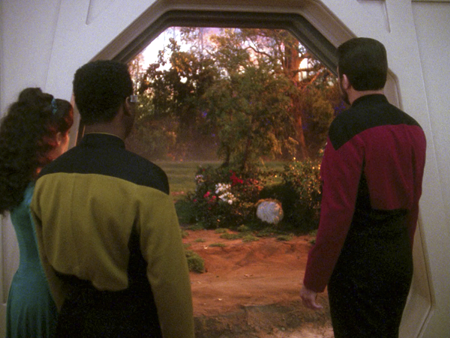
WAIT . . . ARE THEY MAKING THAT UP?
FROM WARP DRIVE AND TRANSPORTERS TO MAGIC HEALING RAYS, TREK’S WRITERS LOOKED TO SCIENCE FOR INSPIRATION. WHAT’S REALISTIC, AND WHAT’S NOT?
BY JUSTIN WORLAND

Actor Ethan Phillips stars as Neelix, the ship’s cook, in Voyager. In one episode, Neelix is merged with Tuvok, a Vulcan, into a single being.
IN THE SECOND SEASON OF STAR TREK: VOYAGER—THE FOURTH live-action television incarnation of the franchise—two key characters find themselves in a dramatic predicament. Tuvok (the ship’s Vulcan security officer) and Neelix (a Talaxian who serves as local guide as well as ship’s cook) are returning from an expedition to collect botanical samples from a nearby planet. When they are beamed back to Voyager along with some alien plant life, they wind up fused into a single being, who decides to call himself “Tuvix” to reflect his two constituent parts. Voyager’s doctor and officers spend the remainder of the episode figuring out how they might reverse the process—and whether it’s ethical to do so.
In many ways, it’s a typical Star Trek episode, with crew members in peril and a high-stakes moral dilemma. It’s also exemplary in another way: the writers looked to actual science to find ideas for their science fiction. The creators intended the merging of the two characters to be a 24th-century extension of the theory of symbiogenesis, which 20th-century scientists developed to explain key aspects of evolution, explains André Bormanis, a writer and science consultant on the show. During symbiogenesis, two distinct organisms merge and form a symbiotic relationship. Current research suggests that symbiogenesis was behind key aspects of the cells in our body, including the essential mitochondria, which provide energy to sustain life.
“That was front and center of the story,” says Bormanis of symbiogenesis in the “Tuvix” episode. “Something like that happened on a larger scale.”
Throughout Star Trek’s 50 years of history, its writers have turned to science to find inspiration for their stories—and Trek, in turn, has inspired many fans to explore real-life science. “Half of the scientists and engineers that I’ve met or worked with have cited Star Trek as one of the big reasons they’ve gotten interested in science,” says Bormanis. “You can use Star Trek as a teaching example of basic scientific concepts.
Of course, a futuristic space drama is at liberty to stretch the bounds of what’s plausible, and Star Trek’s writers have made the most of that. At times, characters could veer into a barrage of technical dialogue that sounded science-y enough but seemed to provide more of a gloss of realism than any true insights about science. In fiction, that’s known as “technobabble,” and it was notorious enough in Star Trek that fans now refer to “Treknobabble.” Still, in many cases, writers were drawing on hard science as the starting point for their tales, even when the onscreen portrayals turned out to be improbable or, in some cases, downright impossible.
WARP DRIVE, THE ENGINES THAT PROPEL Star Trek’s ships faster than the speed of light, may well be the show’s signature science-fiction concept. For storytellers, warp drive solves a critical problem: In a gigantic universe, how do you move your characters around swiftly to explore, as Trek promises, “new life and new civilizations”? Starships can activate warp drive when they need to make a quick escape or travel long distances—often between planets light-years away from each other. Ships traveling at “warp factor one” are traveling at the speed of light, or about 186,000 miles per second. (In contrast, NASA’s New Horizons probe to Pluto—one of the fastest human-created craft ever—traveled from Earth to the edge of the solar system at about 10 miles per second.)
But for would-be space travelers, there’s a big problem with warp drive. Albert Einstein’s special theory of relativity, which explains the relationship between space and time, lies at the heart of the issue. The theory holds that the energy required to move—and accelerate—an object increases exponentially the faster an object is going. And, as an object goes faster, some of the energy applied to it turns into mass instead of inducing acceleration. The upshot: to move at the speed of light would require infinite energy. The theory has been tested—and confirmed—time and again, including in particle accelerators that fire tiny protons at up to 99% of the speed of light.
So is there any hope for the five-year missions of the future? Although scientists consider Einstein’s special theory of relativity to be incontrovertible, some have looked for loopholes—theories that might reconcile relativity with light-speed travel. The most notable would require a spacecraft to contract space-time in front of it and expand space-time behind it. That method would employ negative matter, something that remains purely hypothetical—a far-out theory.
Even if warp drive is impossible, scientists are nevertheless inventing new and exciting ways to travel faster through space. Researchers funded by Russian billionaire Yuri Milner are developing tiny space probes that will be able to travel close to the speed of light, using lasers to propel them. The method would reduce travel time to Mars to just a few days and could be ready to go in just a matter of decades, researchers say. And even though those devices will be far too small to carry humans, they would mark a significant step toward faster travel for other craft.
OK, maybe it’s not so easy to get around the stars. But what about zipping around a planet—or, as was so often necessary in Star Trek, getting from an orbiting ship down to the surface? Capt. Kirk and his crew accomplished this with the transporter—a device that, along with the fading sound effect that it generates, ranks among the show’s most iconic science-fiction technologies. The transporters, which are best thought of as teleportation devices, disassemble people in one location to create an “energy pattern” and then put them back together somewhere else.
Here, too, Star Trek writers were initially looking to solve a 20th-century conundrum: for a television show with a tight budget and only an hour to tell its stories, it was too costly in special effects and time to send crew members back and forth in shuttle craft. The transporter came to the rescue, instantly beaming characters everywhere with a relatively low-tech sparkle effect.
The problems with the concept of transporters are many and significant. “Dematerializing” a person—as it’s known in Star Trek lingo—is theoretically possible under Einstein’s mass-energy equivalence. Mass can be converted to energy, and vice versa, under the parameters of the equation E = mc2. How you might actually go about that is anyone’s guess—the amounts of energy would make an atomic bomb look like a firecracker. And good luck putting billions of particles back together at a new location exactly as they were before being dematerialized. “How would you store all the information? How would you even scan a person in a level of detail?” asks Bormanis incredulously. “I personally think it’s crazy.”
There’s a more philosophical argument against the idea of a transporter: Would the person who emerges at the other end of the beam be the same person who was dematerialized? Converting people into a stream of particles would, it seems, effectively kill them. That a molecularly exact duplicate would be constructed at the other end of the beam might offer little solace.
FOR A FUTURISTIC DEVELOPMENT THAT FEELS more grounded in today’s high tech, consider Star Trek’s holodecks. These are essentially immersive virtual-reality rooms that crew members can use to experience practically anything they can imagine and travel to simulated versions of places both real and fictitious. On the surface, that sounds a lot like virtual-reality platforms such as Oculus Rift and HTC Vive that have popped up in recent years.
The virtual-reality systems of today represent a stunning advancement in immersive escape. Special goggles provide three-dimensional visuals, and clever audio technologies reinforce the illusion. But developing today’s technology into holodecks represents a giant leap that is unlikely to occur anytime soon. The biggest problem may be that holodecks create a world that users not only see and hear but also touch and feel. The Treknobabble that was used to explain this alludes to “force fields” that created 3-D, touchable images that appeared to be solid. Today’s virtual-reality pioneers think there may be ways to trick our sense of touch with air jets and pressure devices. But that still leaves the question of other sensations, such as the taste and smell of the food a holodeck participant consumes.
The holodeck environment also runs into stumbling blocks in the way it portrays artificial intelligence. The device allows users to interact with virtual humans and other creatures that technically do not exist but can think and respond intelligently. Artificial intelligence, which has advanced significantly since the dawn of Star Trek, remains far from sophisticated enough to offer a convincing depiction of a human being—though many computer experts believe machines may one day be able to think.
Meanwhile, current-day engineers continue to look for ways to get closer to the vision of a holodeck. At the University of Illinois at Chicago, researchers are experimenting with a virtual-reality space called CAVE2 that places users in a room surrounded by liquid-crystal displays. Fittingly, one graduate student has already used it to reproduce a version of Star Trek’s Enterprise.
NO STAR TREK ACTION SEQUENCE WOULD BE complete without the ubiquitous phaser guns. Handheld versions of the devices shoot beams to kill enemies (they also have a “stun” setting to incapacitate bad guys without harming them); giant shipboard phasers target opposing vessels in Trek space battles.
Here on Earth, the science behind beam weapons is fairly clear and has been under development by the U.S. military and others for decades. Lasers rely on projecting a narrow stream of high-energy light onto a target, heating it up and destroying it. Many of the U.S. military tests are said to have been successes, but the devices have yet to enter into widespread use. And even the successful tests have worked only under controlled conditions and require large devices mounted on ships or aircraft.
The biggest problem for creating a hand-held phaser gun remains storing enough energy to actually power the device. With today’s technology, a laser with the power to kill someone would require a huge battery, not one that can easily be lugged around. And that battery would heat up when fired, meaning a phaser user would probably require an additional device to keep the battery from overheating. Overcoming these hurdles may be feasible in the coming decades and centuries—the fundamental science is there—but for now, phaser development isn’t practical.
If high-tech weapons can hurt people, are there high-tech ways to treat them? In Star Trek, healing rays can fix injuries—internal and external—with a simple flash of light that lasts a few seconds. The show doesn’t explain the exact scientific justification for what seems like a medical miracle, but it turns out that small handheld devices that can treat some ailments already exist.
Take a device under development by researchers at the University of Washington that uses ultrasound rays to seal holes in punctured organs. The device, about the size of a golf ball, plugs into a scanner held by a doctor. The doctor waves the device over the relevant body area, and invisible ultrasound waves heat the area until it becomes so hot that it fuses, closing the puncture. Researchers say it could be used to treat injuries to a variety of organs, from the liver to the kidney. The technology could transform a slew of surgical procedures—if and when it hits the market. A less dramatic version of ultrasound therapy that has been readily available for decades lets doctors use a handheld device to heat underlying tissue, which in turn can improve blood flow. Sports doctors and physical therapists in particular often rely on the treatment.
The devices and concepts in Star Trek illustrate how difficult it can be to hew to reality in extrapolating what science might achieve in the coming centuries. But that’s also part of what has made the franchise so intriguing for generations of scientists. Bormanis, the writer and science consultant, says he loves when scientific inquiries “get people talking and raise questions.”
And there are so many questions Star Trek has raised. The show’s time frame is close enough that we can see the technological roots of what’s to come but far enough away that it would be impossible to say much with any certainty. The concepts and plotlines in the show challenge the scientifically inclined to imagine what human ingenuity might uncover in the coming centuries. “ Star Trek was supposed to be a very optimistic view of the future,” says Bormanis. “I think it encouraged people to think about using science constructively to improve human life and improve the environment. And expand our opportunities.”


Crew members can be moved from ships to planet surfaces via transporters—fictional devices that beam beings as “energy patterns” (by way of low-budget special effects).

From left: The Next Generation characters Deanna Troi, Geordi La Forge and William Riker prepare to enter the holodeck, a sort of virtual-reality system used for various purposes, such as training and entertainment.

Lt. Reginald Barkley uses the holodeck in The Next Generation episode “Hollow Pursuits,” which originally aired in 1990.

Phasers are energy weapons employed in the fictional universe; real laser weapon technology at Trek level is most likely a long way off.
Justin Worland writes about science and the environment for TIME.